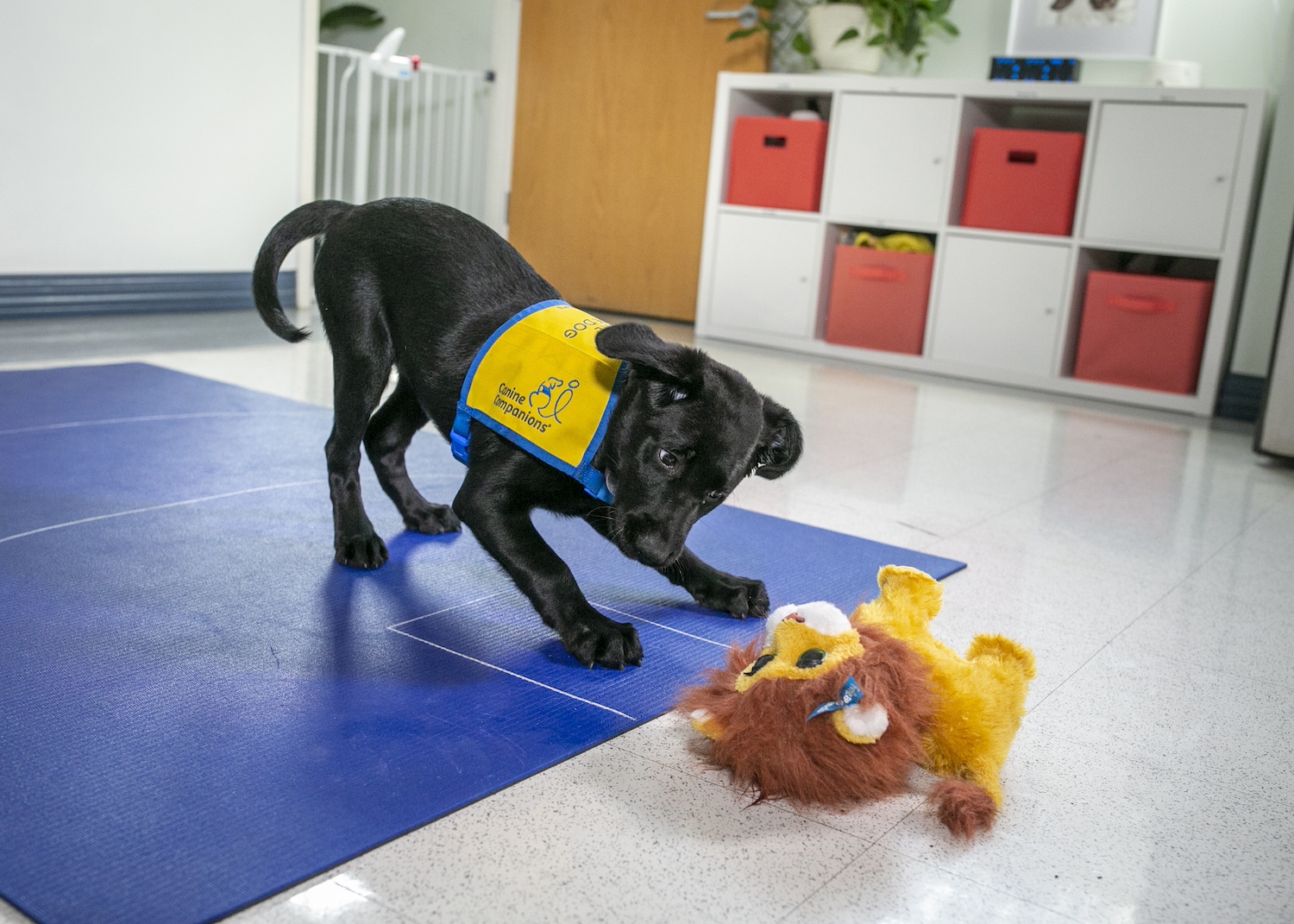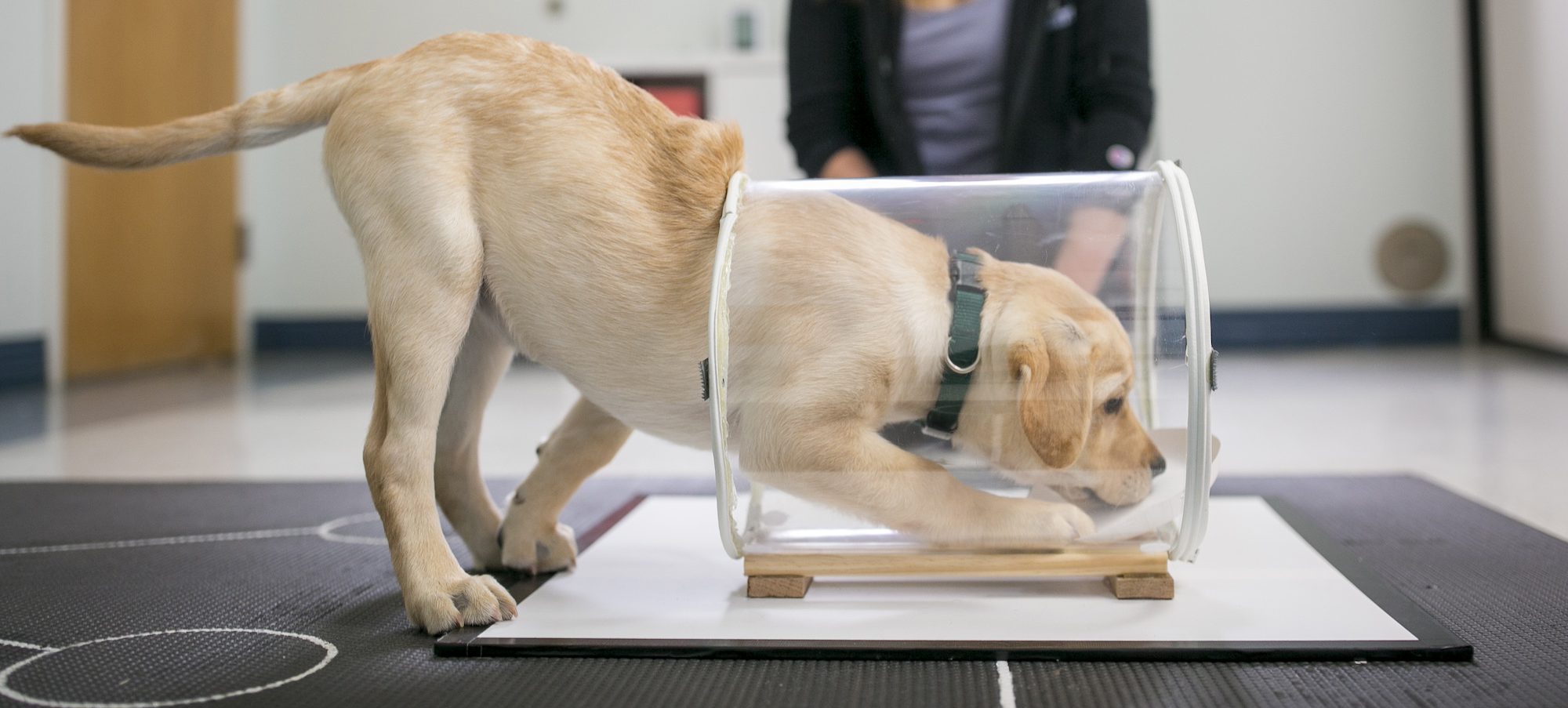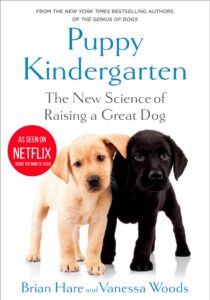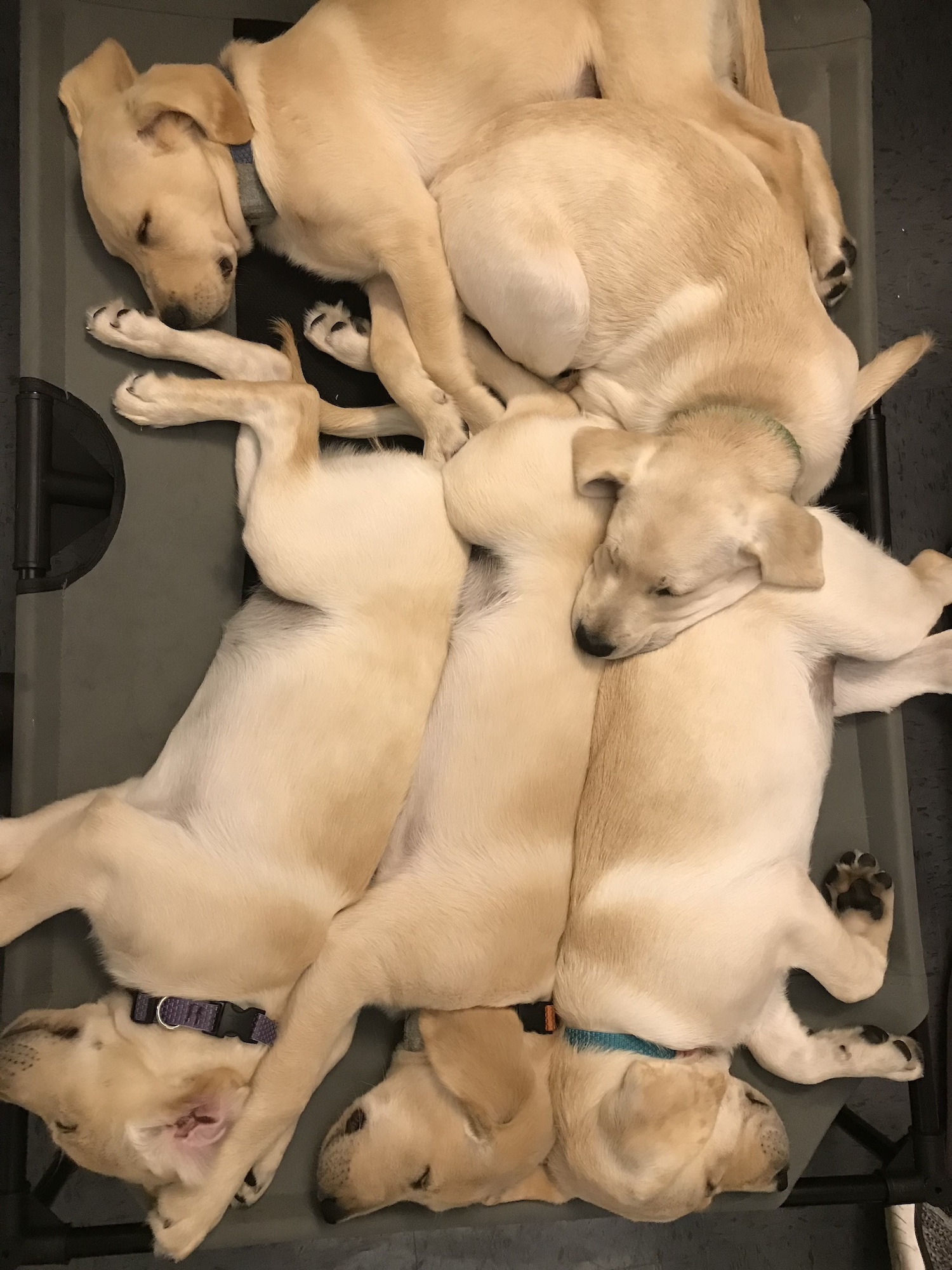Research scientist Vanessa Woods runs Duke University’s Puppy Kindergarten. Since 2018, the program has helped raise more than 100 puppies bred for work as service dogs. The puppies, from Canine Companions, arrive when they’re 8 weeks old and leave when they’re 20 weeks old. During their time there, the puppies participate in a variety of games designed to measure their cognitive abilities.
Woods and her husband, Dr. Brian Hare—a neuroscientist who founded Duke University’s Canine Cognition Center—want to use the information gleaned from the Puppy Kindergarten to figure out what predicts success in service dogs and place more of them with the people who need them. They wrote about their research in the book Puppy Kindergarten (there’s no point in fiddling with such a catchy name when it’s time to sell some hardcovers).
“We’re in this moment right now where what we’re asking of our dogs is different than what it used to be even a generation ago,” Woods says. “We feel like our dogs are much more a part of our families, so we want them to come on vacations, or be in the family photo, and a lot of them are sleeping on the bed. This requires different behaviors from the ones we were used to.”
But service dogs have always been by their humans’ side in all sorts of environments, so what Woods and Hare have learned isn’t just applicable to working dogs; it can also help everyday dog people bond with and train their own best friends. Here’s some of what Woods has to say about the magic of eye contact, the limits of breed generalizations, and how a short walk can do wonders for behavior.
Puppy Kindergarten is available now.

Gloria meets a robot.
Dogs want to play
Dogs’ performance in Puppy Kindergarten varied—not every student was an expert at every game—but they all seemed to have a good time.“We found that dogs were just like kids,” says Woods. “They really like playing games with you. And so the puppies loved the kindergarten.”
As such, she suggests playing games with your dog, even if they’re not destined to become a service animal. These don’t have to be complicated—as long as it’s fun and interesting, the play will benefit both of you.
“One of the big reasons we wrote the book,” Woods says, “is that we wanted people to be able to play and interact with their dog in a new way and learn a little bit about how their mind works.”
The game Woods most recommends trying with your dog is the “impossible task,” which she describes as “both a game and an intervention.” In this task, Woods says, “You put a treat in a snap-lock container and put the lid on a little bit so [your dog knows] they can get it. And then, all of a sudden, you lock it so they can’t get the treat anymore. And the game isn’t whether or not they can get the treat. It’s what they do. Some dogs are really self–problem-solvers. They kind of scratch at the container and see if they can get through. But other dogs will look at you, and some will come and tap you, like, ‘Hey, you’ve got thumbs. Open this for me.’”
Woods says that the impossible task had real, measurable benefits for the human-dog bond. “Puppies who played this for five minutes every two weeks from 8 to 20 weeks old made double the amount of eye contact as puppies who didn’t,” she says. This matters because “eye contact is really important for bonding and the relationship between dogs and their owners.”
Of course, if your dog asks for help getting the treat, or tries to get it, give it to them. The impossible task shouldn’t really be impossible, and should be fun and not frustrating. After a maximum of 90 seconds, make sure your dog gets the treat.
 Like people, dogs have natural talents
Like people, dogs have natural talents
Some dogs seem to be born with an aptitude for one task or another. Frequent Digest source Dr. Stanley Coren, who’s seen six-week old golden retrievers fetch plush toys with no training, could tell you that. Woods says that dogs who are good at certain skills as young puppies tend to stay that way—but that all dogs improve with training.
“It’s never a question of nature or nurture,” Woods says. “It’s always going to be a little bit of both. Some puppies are going to come out with excellent memories, or be really good communicators. Something that we were interested in was trying to figure out how those individual differences when they’re young predicted their performance when they got older. Of course they are going to improve, but we did find that a lot of these cognitive skills were consistent—so a dog that was really good at communicative gestures when they were a puppy was on the high end of doing that when they were adults.”
So lean into your dog’s strengths, but don’t despair if they don’t nail everything right away.

Dogs are always learning
You can teach a dog a skill intentionally, but they’ll also pick up a lot just by watching the world around them.
“There is research that shows that dogs learn from their mothers in detection,” Woods says, referring to dogs who are trained to sniff out various scents. And dogs at the Puppy Kindergarten also learned from her own dog, Congo, himself a former service dog. “We definitely saw Congo modeling behaviors that the puppies could follow,” she says. “And I don’t think this should be a surprise to anyone—even bees do that. If a bee sees another bee solving a problem, they’re more likely to be able to solve the problem. We know that dogs can do that too.”
Breed differences exist, but individual differences matter more
Genes passed down through generations can impact not only how dogs look, but also some behavioral tendencies and abilities—which is why dogs bred specifically for tasks like retrieving and hunting may be better at them. So, yes, there are differences between breeds. But, Woods says, there is also tremendous individual variation within them. In the book, she and Dr. Hare wrote that Labrador retrievers who become military dogs are “so temperamentally and cognitively distinct from service dogs that they might as well be a different species.” And, they continued, “even puppies from the same litter can be very different.”
The fact that you can’t count on breed to guarantee a personality is one reason that, if you’re considering bringing a new dog into your family, Woods advocates fostering an adult. Spending time with a dog whose personality is already known is a much better way to gauge whether they’ll fit into your life than bringing home a puppy and betting on what you’ve heard about their breed’s tendencies.
“If you really have restrictions,” she says, “We always suggest getting an adult dog.”

Tired puppies!
Exercise can help with behavior—but don’t go overboard
In their book, Woods and Hare wrote that “most puppy behavior problems can be solved with a walk.”
This doesn’t mean to drive your puppy to exhaustion. “We had a lot of little walks,” Woods says of the dogs in her program. If your puppy gives up or starts panting, don’t push them. We’d add to follow generally accepted guidelines on how much exercise is appropriate for puppies; find details here. For questions about your specific dog, ask your vet.
“We look for things like destructive behavior, really rough play,” Woods says. “If they look like a kid that needs to get out, we usually just take them for a short walk. Everybody feels better when they get back.”
Management is important, too
Part of recognizing dogs’ individual personalities, Woods says, is setting them up for success. “If a kid has really poor self-control,” she says, “you’re going to try to avoid situations where they’re tested too frequently, and you’re going to teach them skills to overcome it.” So combine your training with management. If you know that your dog is tempted to grab things they shouldn’t, she advises, “don’t keep stuff on the counter.” If they like shredding your kid’s favorite toy, “put it out of the way.”

Behavioral quirks can have silver linings
If you know how to harness them, qualities that might not seem ideal can be boons to you and your dog. One example Woods gives is an apparent lack of self-control. “Dogs who have better self-control” as puppies, she says, “are more likely to graduate as service dogs.” This may not be surprising. But she goes on to say that “dogs with worse self-control are more likely to graduate as military dogs.”
This does not mean that those dogs never learn how to control themselves—dogs who are sniffing for bombs need to know what they’re doing, or the results could be disastrous. But, Woods says, “These bomb-sniffing dogs have to go toward danger when everybody else is running away. And the other thing is that they have to be really uninfluenced by their handler.” As such, boldness and independence in a puppy are a good signs for their future success in that field.
And, as bizarre as it sounds, Woods and Hare wrote that puppies who ate poop might even be more likely to succeed as service dogs (But, please, do not let your dog eat poop—it can be dangerous, especially if it’s not their own. For details, and tips on how to help them kick the habit, read our guide to the topic).
The authors cited research by Dr. Emily Bray, of the Canine Cognition Center at the University of Arizona. According to responses she received from puppy raisers working with aspiring guide dogs, the poop eaters were more likely to graduate. So if you’ve seen a bumper sticker that reads “My honor student eats poop,” that’s probably why.
“That was a fun correlation that gave us hope for a lot of our puppies,” Woods says, “because it’s quite a common behavior.”









